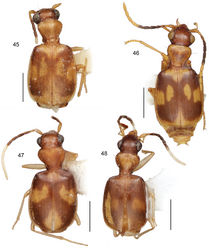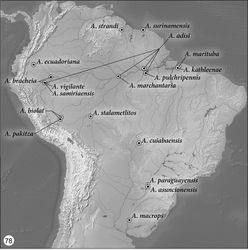Asklepia marituba
| Notice: | This page is derived from the original publication listed below, whose author(s) should always be credited. Further contributors may edit and improve the content of this page and, consequently, need to be credited as well (see page history). Any assessment of factual correctness requires a careful review of the original article as well as of subsequent contributions.
If you are uncertain whether your planned contribution is correct or not, we suggest that you use the associated discussion page instead of editing the page directly. This page should be cited as follows (rationale):
Citation formats to copy and paste
BibTeX: @article{Erwin2014ZooKeys430, RIS/ Endnote: TY - JOUR Wikipedia/ Citizendium: <ref name="Erwin2014ZooKeys430">{{Citation See also the citation download page at the journal. |
Ordo: Coleoptera
Familia: Carabidae
Genus: Asklepia
Name
Asklepia marituba Zamorano & Erwin sp. n. – Wikispecies link – ZooBank link – Pensoft Profile
Holotype
Brazil, Pará, Marituba, Ananindeua, 1.3712 °S, 48.3689°W, 10m, (F.M. Oliveira, P. Wygodzinsky)(AMNH: ADP132494, female).
Derivation of specific epithet
The specific epithet, marituba, is a singular Latinized feminine noun in apposition, based on the name of the place where these beetles are found.
Proposed english vernacular name
Marituba pattern-wing beetle.
Diagnosis
With the attributes of the genus Asklepia as described by Liebke (1938)[1] and as noted above under the generic diagnosis, and medium-size for the genus (SBL = 2.732 mm). Adults with head and prothorax aurantiacus, elytral maculae fulvous; elytron brunneus with scutellar area flavous, a broad flavous macula transversely oriented in the medial lateral quadrant, barely prolonged into the medial proximal quadrant, and a narrow oval flavous macula in the proximal apical quadrant, macula extended to the sutural area; metasternum, abdominal sterna III-VI, and epipleuron flavotestaceous, abdominal sternum VII infuscated; legs testaceous; antennal scape and pedicel fulvous, antennomeres 3–7 infuscated, 8–11 white. Dorsal surface devoid of microsculpture, surface luster very shiny. Pronotum markedly convex with lateral margin effaced except just anterior to hind angle and there a simple bead; hind angle slightly prominent; median line feebly defined. Elytral interneurs effaced from the greater part of the elytron, only visible as scattered coarse punctures.
Description
(Habitus, Fig. 47). Size: [See also Table 19] Medium-size for the genus; ABL = 2.924 mm, SBL = 2.732 mm, TW (total width) = 0.820 mm, LP = 0.605 mm, WP = 0.768 mm, LE = 1.694 mm. Color: See diagnosis above. Luster: See diagnosis above. Head (Fig. 47): as in description for genus above. Prothorax. Pronotum (Fig. 47) moderately broad, as wide as head across eyes, (WH/WP: 1.069), longer than head (LP/LH: 1.398), slightly wider than long (WP/LP: 1.268); markedly cordiform and explanate, lateral margin beaded with seta at anterior third; base markedly constricted with medial lobe at base; anterior angles moderately produced, hind angle slightly produced, a right angle, and setose; median line markedly defined, basal and apical transverse impressions punctate, punctures infuscated; surface smooth throughout. Pterothorax. Normal for genus, see description for genus above. Elytra slightly convex; at apical third twice as wide as head across eyes (WH/TW: 0.521) and pronotum (WP/TW: 0.488), longer than wide. Elytral interneurs evident as rows of continuous punctures; punctures homogeneous. Hind wings fully developed. Legs. Overall, normal for genus, see description for genus above. Abdominal sterna. Overall, normal for genus, see description for genus above. Male genitalia. Male unknown. Female genitalia. Not investigated, presumably similar to that of Asklepia demiti sp. n.
Dispersal potential
These beetles are macropterous and probably capable of flight; they are attracted to lights. They are moderately swift and agile runners.
Distribution
(Fig. 78). This species has been found at only one location on a white-water system on the lower Río Amazonas. But that does not at all indicate its real distribution: as has been pointed out above, very small beetles are inadequately sampled, especially in the Neotropics.
Way of life
See Erwin (1991)[2] for a general description. Nothing is known about the way of life of this species.
Other specimens examined
None.
Original Description
- Erwin, T; Zamorano, L; 2014: A synopsis of the tribe Lachnophorini, with a new genus of Neotropical distribution and a revision of the Neotropical genus Asklepia Liebke, 1938 (Insecta, Coleoptera, Carabidae) ZooKeys, 430: 1-108. doi
Images
|

